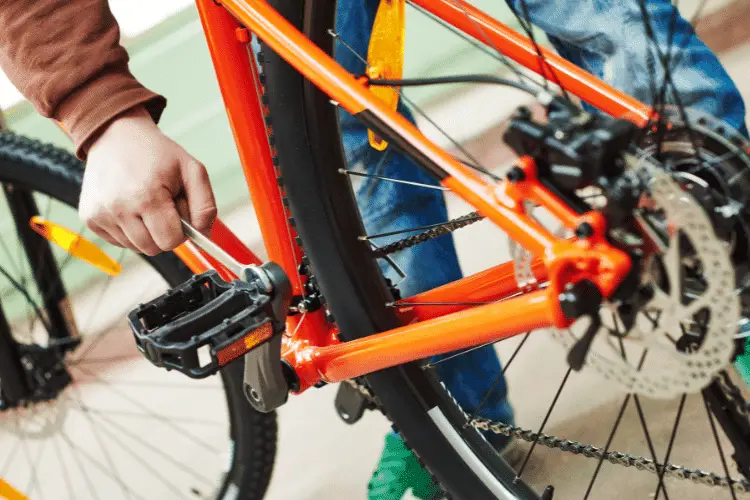As a cyclist, there’s nothing more frustrating than trying to shift gears and realizing your rear derailleur won’t shift up.
Proper shifting is crucial for a smooth and efficient ride, but sometimes the derailleur won’t cooperate. If you’re experiencing this issue, don’t worry, you’re not alone.
In this article, we’ll explore the top 10 reasons why your rear derailleur won’t shift up and provide actionable solutions to get you back on the road.
From cable tension to worn-out pulleys, we’ll cover everything you need to know to diagnose and fix the problem.
So, let’s get started and help you get your bike running smoothly again.
Quick Navigation
8 Reasons Why Won’t My Rear Derailleur Shift Up

1. Cable Tension is Too Loose
When you shift gears, the cable tension pulls the derailleur up or down the cassette. If the tension is too loose, the derailleur won’t move up the cassette, and you’ll have difficulty shifting to higher gears.
Symptoms of loose cable tension
Some common symptoms include difficulty shifting to higher gears, the chain falling off the cassette, or slipping.
Steps to adjust cable tension
Shifting your bike to the highest gear. Then, loosen the cable bolt and pull the cable tight with pliers.
Tighten the bolt back up and try shifting again. Repeat the process until the shifting feels smooth, and the chain stays on the cassette.
Be sure not to make the tension too tight, as it can cause issues when shifting to lower gears.
2. Cable Tension is Too Tight
If the cable tension is too tight, it will pull the derailleur too far up the cassette, making it difficult to shift to lower gears.
Symptoms of tight cable tension
Some common symptoms of tight cable tension include difficulty shifting to lower gears, chain skipping, or derailleur clicking.
Steps to adjust cable tension
To adjust cable tension, shift your bike to the lowest gear. Then, loosen the cable bolt slightly until the derailleur is aligned with the lowest gear.
If the chain still skips or the shifting is difficult, adjust the cable tension by tightening the cable bolt slightly until the shifting feels smooth.
Keep the tension tight enough, as it can cause issues when shifting to higher gears.
3. Derailleur Hanger is Bent
A. Explanation of derailleur hanger The derailleur hanger is a small metal piece that attaches the derailleur to the frame. If it’s bent or misaligned, it can cause issues with shifting.
Symptoms of a bent derailleur hanger
Symptoms of a bent derailleur hanger Some common symptoms include difficulty shifting, the chain rubbing against the derailleur, or the derailleur appearing crooked.
Steps to fix a bent derailleur hanger:
To fix a bent derailleur hanger, you’ll need to use a derailleur hanger alignment tool or take your bike to a bike shop for professional help.
The tool will allow you to straighten the hanger by gently bending it back into place.
It’s important to ensure the hanger is aligned correctly to avoid any further issues with shifting.
4. Derailleur Limit Screws Are Misaligned
Limit screws are small screws on the derailleur that limit movement to prevent the chain from shifting off the cassette or into the wheel’s spokes.
Symptoms of misaligned limit screws
Symptoms of misaligned limit screws Some common symptoms of misaligned limit screws include difficulty shifting, the chain falling off the cassette, or the derailleur making a clicking sound.
Steps to adjust limit screws
To adjust the limit screws, shift your bike to the smallest gear and check the alignment of the derailleur with the cassette.
The upper limit screw should be adjusted, so the jockey wheel is aligned with the smallest cog without rubbing against it.
Next, shift your bike to the largest gear and adjust the lower limit screw, so the jockey wheel is aligned with the largest cog without rubbing against it.
It’s important to make sure both limit screws are properly aligned to prevent any issues with shifting.
5. Derailleur Cable is Frayed or Damaged
Explanation of frayed or damaged derailleur cable Over time, the derailleur cable can become frayed or damaged, which can cause issues with shifting.
Symptoms of frayed or damaged derailleur cable
Symptoms of frayed or damaged derailleur cable Some common symptoms of a frayed or damaged derailleur cable include difficulty shifting, the chain slipping, or the derailleur making a clicking sound.
Steps to replace the derailleur cable
To replace the derailleur cable, you’ll need to first remove the old cable by loosening the cable bolt and pulling the cable through the derailleur.
Next, thread the new cable through the derailleur and through the cable housing.
Finally, tighten the cable bolt and adjust the tension as needed. Be sure to trim any excess cable to avoid getting caught on anything.
6. Derailleur Pulleys Are Worn Out
An explanation of derailleur pulleys is small wheels on the derailleur that guide the chain as it moves up and down the cassette.
Over time, these pulleys can become worn out, which can cause issues with shifting.
Symptoms of worn-out derailleur pulleys
Some common symptoms of worn-out derailleur pulleys include difficulty shifting, the chain slipping, or the derailleur making a grinding sound.
Steps to replace derailleur pulleys
To replace the derailleur pulleys, you’ll need to first remove the old pulleys by unscrewing the bolts that hold them in place.
Next, install the new pulleys and tighten the bolts. It’s important to make sure the pulleys are properly aligned and spinning smoothly to prevent any issues with shifting.
7. Chain is Stretched or Worn Out
A. Explanation of stretched or worn-out chain Over time, the chain can become stretched or worn out, which can cause issues with shifting.
A stretched chain can no longer fit properly on the cassette, which can cause slipping and difficulty shifting.
Symptoms of a stretched or worn-out chain
Some common symptoms of a stretched or worn-out chain include difficulty shifting, the chain slipping, or the derailleur making a clicking sound.
Steps to replace the chain
To replace the chain, you’ll need to first remove the old chain by using a chain tool to break the chain.
Next, install the new chain by threading it through the derailleur and cassette and using the chain tool to connect the ends of the chain.
It’s important to make sure the chain is properly sized and lubricated to prevent any issues with shifting.
8. Cassette Teeth Are Worn Out
A. Explanation of worn-out cassette teeth Over time, the teeth on the cassette can become worn out, which can cause issues with shifting. Worn-out teeth can no longer provide a proper grip on the chain, which can cause slipping and difficulty shifting.
Symptoms of worn-out cassette teeth
Some common symptoms of worn-out cassette teeth include difficulty shifting, the chain slipping, or the derailleur making a grinding sound.
Steps to replace the cassette
To replace the cassette, you’ll need to first remove the old cassette by loosening the lockring with a cassette tool.
Next, install the new cassette by threading it onto the freehub body and tightening the lockring.
It’s important to make sure the cassette is properly aligned, and the teeth are in good condition to prevent any issues with shifting.
Conclusion
In conclusion, if you’re experiencing issues with your rear derailleur not shifting up, there are a number of potential causes to consider.
By identifying and addressing these issues, you can get your bike back in working order and enjoy a smooth, reliable ride.
From checking the limit screws and derailleur alignment to examining the chain, cassette, and derailleur hanger, there are many steps you can take to diagnose and fix the problem.
If you’re uncomfortable doing the repairs, taking your bike to a professional bike shop for assistance is always best.
With some troubleshooting and essential maintenance, you can get your bike back on the road and enjoy the freedom of cycling again.
